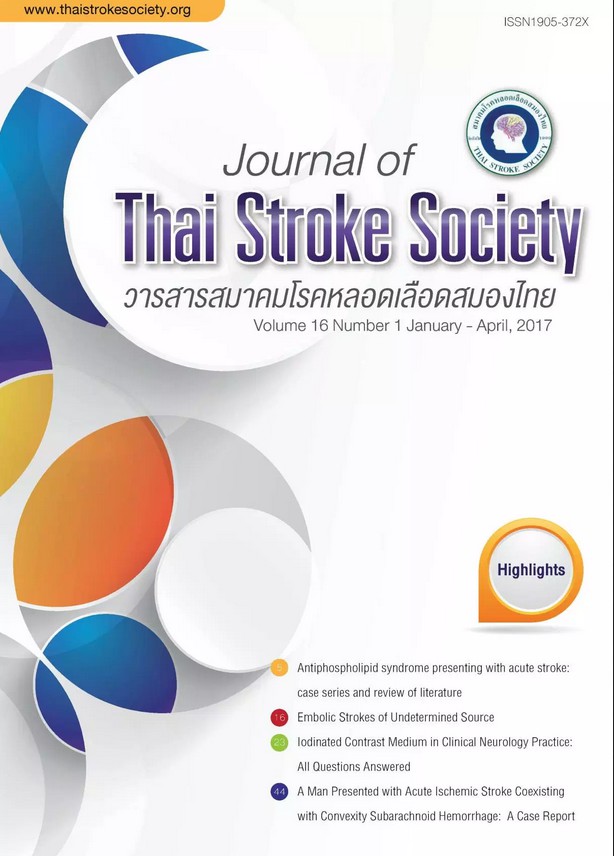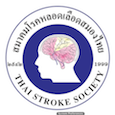Embolic Strokes of Undetermined Source
Keywords:
Embolic Strokes of Undetermined Source, Cryptogenic strokeAbstract
Embolic Strokes of Undetermined Source (ESUS) is a nonlacunar strokes without an identified cardioembolic source, occlusive atherosclerosis and no other specific cause of stroke. The causes of ESUS should be excluded by precordial echocardiography, cardiac monitoring over 24 h and vascular imaging of both the extracranial and intracranial arteries supplying the area of brain ischemia. Currently, there is no specific treatment guideline for ESUS. However, the ongoing large randomized controlled trials are performed for confirm the benefit of anticoagulant in secondary stroke prevention in these patients.
References
stroke data bank. Stroke (2001) 32(11):2559–66.
Putaala J, Metso AJ, Metso TM, Konkola N, Kraemer Y, Haapaniemi E, et al. Analysis of 1008 consecutive patients aged 15 to 49 with first-ever ischemic stroke the Helsinki young stroke registry. Stroke (2009) 40(4):1195–203.
Li L, Yiin GS, Geraghty OC, Schulz UG, Kuker W, Mehta Z, et al. Incidence, outcome, risk factors, and long-term prognosis of cryptogenic transient ischaemic
attack and ischaemic stroke: a population-based study. The Lancet Neurology (2015) 14(9):903–13.
Adams HP Jr, Bendixen BH, Kappelle LJ, Biller J, Love BB, Gordon DL, et al. Classification of subtype of acute ischemic stroke. Definitions for use in a
multicenter clinical trial. TOAST. Trial of Org 10172 in Acute Stroke Treatment. Stroke 24 (1993) 1:35–41.
Hart RG, Diener HC, Coutts SB, Easton JD, Granger CB, O’Donnell MJ, et al. Embolic strokes of undetermined source: the case for a new clinical construct. Lancet Neurol (2014) 13(4):429–38.
Gladstone DJ, Spring M, Dorian P, et al. Atrial fibrillation in patients with cryptogenic stroke. N Engl J Med 2014; 370:2467–2477.
Sanna T, Diener HC, Passman RS, et al. Cryptogenic stroke and underlying atrial fibrillation. N Engl J Med 2014; 370:2478–2486.
Brambatti M, Connolly SJ, Gold MR, et al. Temporal relationship between subclinical atrial fibrillation and embolic events. Circulation 2014; 129:2094–2099.
Sposato LA, Cipriano LE, Riccio PM, et al. Very short paroxysms account for more than half of the cases of atrial fibrillation detected after stroke and
TIA: a systematic review and meta-analysis. Int J Stroke 2015; 10:801–807.
Ntaios G, Papavasileiou V, Milionis H, et al. Embolic strokes of undetermined source in the Athens stroke registry: an outcome analysis. Stroke 2015; 46:2087–2093.
McGrath ER, Paikin JS, Motlagh B, et al. Transesophageal echocardiography in patients with cryptogenic ischemic stroke: a systematic review. Am Heart J 2014; 168:706–712.
Jauss M, Zanette E. Detection of right-to-left shunt with ultrasound contrast agent and transcranial Doppler sonography. Cerebrovasc Dis 2000; 10: 490–496.
Kraywinkel K, Gortler M, Haass AH, et al. D i a g n o s t i c b e n e fi t o f t r a n s e s o p h a g e a l echocardiography after TIA and ischemic stroke. Aktuelle Neurol 2005; 32:129–135.
Alsheikh-Ali AA, Thaler DE, Kent DM. Patent foramen ovale in cryptogenic stroke: incidental or pathogenic? Stroke 2009; 40:2349–2355.
Furlan AJ, Reisman M, Massaro J, et al. Closure or medical therapy for cryptogenic stroke with patent foramen ovale. N Engl J Med 2012; 366:991–999.
Carroll JD, Saver JL, Thaler DE, et al. Closure of patent foramen ovale versus medical therapy after cryptogenic stroke. N Engl J Med 2013; 368:1092–1100.
Meier B, Kalesan B, Mattle HP, et al. Percutaneous closure of patent foramen ovale in cryptogenic embolism. N Engl J Med 2013; 368:1083–1091.
Kent DM, Dahabreh IJ, Ruthazer R, et al. Device Closure of Patent Foramen Ovale After Stroke: Pooled Analysis of Completed Randomized Trials.
J Am Coll Cardiol 2016; 67(8):907-17.
Kent DM, Ruthazer R, Weimar C, et al. An index to identify stroke-related vs incidental patent foramen ovale in cryptogenic stroke. Neurology 2013; 81:
619–625.
Freilinger TM, Schindler A, Schmidt C, et al. Prevalence of nonstenosing, complicated atherosclerotic plaques in cryptogenic stroke. JACC Cardiovasc Imaging 2012; 5:397–405.
Amarenco P, Davis S, Jones EF, et al. Clopidogrel plus aspirin versus warfarin in patients with stroke and aortic arch plaques. Stroke 2014; 45:1248–1257.
Wehrum T, Kams M, Strecker C, et al. Prevalence of potential retrograde embolization pathways in the proximal descending aorta in stroke patients and
controls. Cerebrovasc Dis 2014; 38:410–417.
Mas JL, Arquizan C, Lamy C, et al. Recurrent cerebrovascular events associated with patent foramen ovale, atrial septal aneurysm, or both. N Engl J Med 2001; 345:1740–1746.
Sacco RL, Prabhakaran S, Thompson JL, et al. Comparison of warfarin versus aspirin for the prevention of recurrent stroke or death: subgroup
analyses from theWarfarin-Aspirin Recurrent Stroke Study.Cerebrovasc Dis 2006; 22:4–12.
Halkes PH, van Gijn J, Kappelle LJ, et al. Medium intensity oral anticoagulants versus aspirin after cerebral ischaemia of arterial origin (ESPRIT):
a randomized controlled trial. Lancet Neurol 2007; 6:115–124.
Clinical trials. (2017). Available from: https://clinicaltrials.gov/ct2/show/ NCT02239120. Accessed 1 January 2017.
Clinical trials. (2017). Available from: https://clinicaltrials.gov/ct2/show/ NCT02313909. Accessed 1 January 2017.
Clinical trials. (2017). Available from: https://clinicaltrials.gov/ct2/show/ NCT02427126. Accessed 1 January 2017.
Downloads
Published
How to Cite
Issue
Section
License
ข้อความภายในบทความที่ตีพิมพ์ในวารสารสมาคมโรคหลอดเลือดสมองไทยเล่มนี้ ตลอดจนความรับผิดชอบด้านเนื้อหาและการตรวจร่างบทความเป็นของผู้นิพนธ์ ไม่เกี่ยวข้องกับกองบรรณาธิการแต่อย่างใด การนำเนื้อหา ข้อความหรือข้อคิดเห็นของบทความไปเผยแพร่ ต้องได้รับอนุญาตจากกองบรรณาธิการอย่างเป็นลายลักษณ์อักษร ผลงานที่ได้รับการตีพิมพ์ในวารสารเล่มนี้ถือเป็นลิขสิทธิ์ของวารสาร





